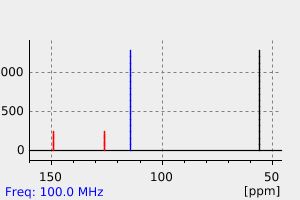2,3,7,8-Tetramethoxyselenanthren | 50499-86-0
中文名称
——
中文别名
——
英文名称
2,3,7,8-Tetramethoxyselenanthren
英文别名
2,3,7,8-tetramethoxyselenanthrene;Selenanthrene, 2,3,7,8-tetramethoxy-
CAS
50499-86-0
化学式
C16H16O4Se2
mdl
——
分子量
430.221
InChiKey
RYTMZQYCULTDRR-UHFFFAOYSA-N
BEILSTEIN
——
EINECS
——
-
物化性质
-
计算性质
-
ADMET
-
安全信息
-
SDS
-
制备方法与用途
-
上下游信息
-
文献信息
-
表征谱图
-
同类化合物
-
相关功能分类
-
相关结构分类
物化性质
-
沸点:504.7±60.0 °C(Predicted)
计算性质
-
辛醇/水分配系数(LogP):-0.66
-
重原子数:22
-
可旋转键数:4
-
环数:3.0
-
sp3杂化的碳原子比例:0.25
-
拓扑面积:36.9
-
氢给体数:0
-
氢受体数:4
SDS
上下游信息
-
下游产品
中文名称 英文名称 CAS号 化学式 分子量 —— 2,3,7,8-Tetramethoxyselenanthren-5,5-dibromid —— C16H16Br2O4Se2 590.029
反应信息
-
作为反应物:描述:2,3,7,8-Tetramethoxyselenanthren 在 碘 作用下, 以 正己烷 、 甲苯 为溶剂, 生成 2,3,6,7-tetramethoxyselenananthren-radikalkation trijodid参考文献:名称:EINKRISTALL-MOLEKÜLSTRUKTUREN 1071.2: STRUKTURÄNDERUNGEN VON THIANTHREN, 2,3,6,7-TETRAMETHOXYTHIANTHREN UND 2,3,6,7-TETRAMETHOXYSELENANTHREN BEI KOMPLEXBILDUNG MIT ELEKTRONENAKZEPTOREN SOWIE BEI EINELEKTRONENOXIDATION ZU DEN RADIKALKATIONEN摘要:Information on structural changes due to partial and full one-electron transfer is obtained by comparing the single crystal structures of both donor/acceptor complexes of thianthrene and selenanthrene derivatives with those of their radical cation salts: The single crystal structures of {thianthrene ... pyromelliticdianhydride}, {2,3,6,7-tetramethoxythianthrene ... 1,2,4,5-tetracyanobenzene} and 2,3,6,7-tetramethoxyselenanthrene ... 1,2,4,5-tetracyanobenzene} do not exhibit any significant differences relative to that of their components. On the contrary, in the corresponding radical cation salts [2,3,6,7-tetramethoxythianthrene(.+)][Br-3(-)] as well as [2,3,6,7-tetramethoxyselenanthrene(.+)][I-3(-)] severe structural changes are observed such as the flattening of the molecular skeletons or beginning cyanine distortions along the chains H3CO-C-3-X-C-3-OCH3. Accompanying UV/VIS measurements of solutions containing both donor and acceptor prove long-wavelengths charge transfer bands with drastically reduced excitation energies relative to that of the separated molecules. Therefore, in the ground state of the donor/acceptor complexes between electron-rich sulfur donors and suitable accepters, only an almost negligible charge transfer occurs. The weak interactions in the van der Waals complexes can be rationalized by correlation of the respective orbital diagrams with the crystal lattice arrangements determined experimentally. Altogether, prospects for new materials are provided.DOI:10.1080/10426509608037954
-
作为产物:参考文献:名称:EINKRISTALL-MOLEKÜLSTRUKTUREN 1071.2: STRUKTURÄNDERUNGEN VON THIANTHREN, 2,3,6,7-TETRAMETHOXYTHIANTHREN UND 2,3,6,7-TETRAMETHOXYSELENANTHREN BEI KOMPLEXBILDUNG MIT ELEKTRONENAKZEPTOREN SOWIE BEI EINELEKTRONENOXIDATION ZU DEN RADIKALKATIONEN摘要:Information on structural changes due to partial and full one-electron transfer is obtained by comparing the single crystal structures of both donor/acceptor complexes of thianthrene and selenanthrene derivatives with those of their radical cation salts: The single crystal structures of {thianthrene ... pyromelliticdianhydride}, {2,3,6,7-tetramethoxythianthrene ... 1,2,4,5-tetracyanobenzene} and 2,3,6,7-tetramethoxyselenanthrene ... 1,2,4,5-tetracyanobenzene} do not exhibit any significant differences relative to that of their components. On the contrary, in the corresponding radical cation salts [2,3,6,7-tetramethoxythianthrene(.+)][Br-3(-)] as well as [2,3,6,7-tetramethoxyselenanthrene(.+)][I-3(-)] severe structural changes are observed such as the flattening of the molecular skeletons or beginning cyanine distortions along the chains H3CO-C-3-X-C-3-OCH3. Accompanying UV/VIS measurements of solutions containing both donor and acceptor prove long-wavelengths charge transfer bands with drastically reduced excitation energies relative to that of the separated molecules. Therefore, in the ground state of the donor/acceptor complexes between electron-rich sulfur donors and suitable accepters, only an almost negligible charge transfer occurs. The weak interactions in the van der Waals complexes can be rationalized by correlation of the respective orbital diagrams with the crystal lattice arrangements determined experimentally. Altogether, prospects for new materials are provided.DOI:10.1080/10426509608037954
文献信息
-
Gunsser, W.; Henning, J. H.; Klar, G., Berichte der Bunsen-Gesellschaft, 1989, vol. 93, p. 1370 - 1373作者:Gunsser, W.、Henning, J. H.、Klar, G.、Martinez, E. SanchezDOI:——日期:——
-
Preparation and Interconversion of Phenylselenenylated and Alkylselenenylated Aromatic Compounds作者:Lars Engman、Per ErikssonDOI:10.3987/com-95-7377日期:——Phenylselenenyl and alkylselenenyl sulfates were found to efficiently and mildly introduce one or several phenylselenenyl or alkylselenenyl groups into activated aromatic or heteroaromatic compounds. When treated with methylselenenyl sulfate, veratrole and 2,2',3,3'-tetramethoxybiphenyl afforded 2,3,7,8-tetramethoxyselenanthrene and 2,3,7,8-tetramethoxy-dibenzoselenophene, respectively, via oxidative demethylation at selenium/cyclization. Phenyl-selenenylated thiophenes were selectively hydrodeselenenated at the 2- and/or 5-positions by treatment with the appropriate amount of n-butyllithium at -78 degrees C followed by hydrolysis.
-
Hinrichs, Winfried; Berges, Peer; Klar, Guenter, Zeitschrift fur Naturforschung, Teil B: Anorganische Chemie, Organische Chemie, 1986, vol. 41, # 9, p. 1133 - 1141作者:Hinrichs, Winfried、Berges, Peer、Klar, Guenter、Sheldrick, George M.DOI:——日期:——
-
Berges, Peer; Kudnig, Jens; Klar, Guenter, Zeitschrift fur Naturforschung, B: Chemical Sciences, 1989, vol. 44, # 2, p. 211 - 219作者:Berges, Peer、Kudnig, Jens、Klar, Guenter、Martinez, Enrique Sanchez、Calleja, Ricardo DiazDOI:——日期:——
-
Berges, Peer; Hinrichs, Winfried; Klar, Guenter, Journal of Chemical Research, Miniprint, 1986, # 10, p. 3121 - 3136作者:Berges, Peer、Hinrichs, Winfried、Klar, GuenterDOI:——日期:——
表征谱图
-
氢谱1HNMR
-
质谱MS
-
碳谱13CNMR
-
红外IR
-
拉曼Raman
-
峰位数据
-
峰位匹配
-
表征信息







